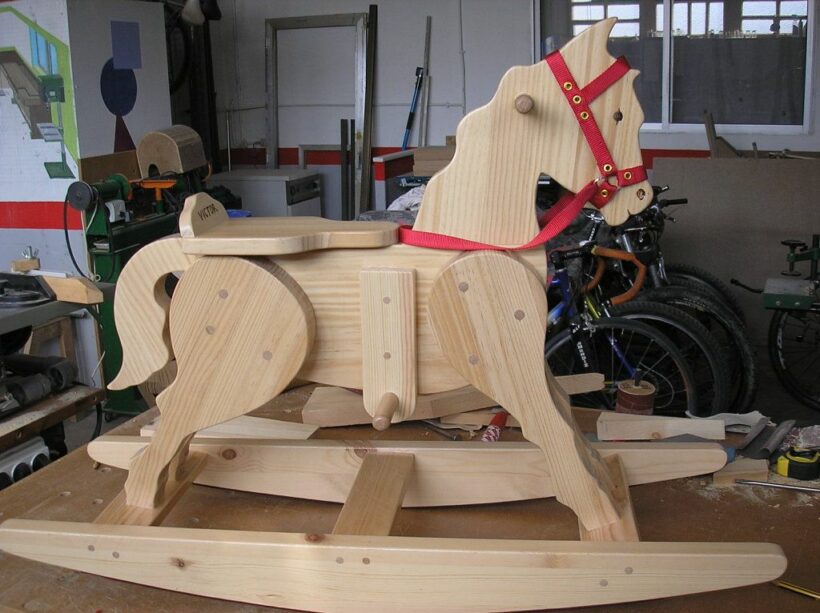The marvellous wooden rocking horse, which survived for centuries and became the symbol of protected childhood, did not make it beyond the frontier of the twentieth century.
Advances in technology also have their downsides. They sometimes present that dark, cheap and populist side of mass consumption objects, which derives from the need to extend their field of influence to the most hidden corners of society in the civilised world.
Toys, for example, show this characteristic in a very illustrative way. Especially when they try to communicate the secrets of science in a language adapted to the total ignorance that a lay public, eager for surprises, manifests about these levels of knowledge.
The old doll-pets that served as company for little girls and allowed them to build a fantastic world around inanimate beings made of rag, plastic, ceramic or wood, and which had the great virtue of forming an obedient and subordinate family, have been transformed into adult women, sophisticated and full of complications; conventional beauties that perfectly fulfil the requirement of representing consumerism in its purest expression.
Surrounded by multi-level mansions, luxury cars, fur stoles, jewelry, tennis courts and even boyfriends, today’s fetish-dolls are gradually transforming simple play into an expensive obstacle course and fierce competition, which serves – what a bonus – as training for future life in society.
If the doll is not transformed into a magazine cover girl, then it becomes a silly little girl who tirelessly repeats English phrases through a recording, or – as has just appeared on the market – into a girl who communicates a series of inane ideas over the telephone.
Today’s dolls are no longer those silent figures who put up with abuse. Now they are the ones who dictate the rules and raise specific issues such as racism, sexuality, health problems or lack of affection. In reality, they become convenient replicas of the mother, who ends up delegating part of her formative task to them.
What is being lost in the meantime is the playful quality of these objects so precious to children. The incorporation of technology in the manufacture of toys has led to an unfortunate atrophy of children’s ability to develop unlimited creativity, as they require more and more stimuli. Pure fun, the ability to abstract from the environment and enter fully into a world entirely created by and for their own pleasure, has been contaminated by an absurd universe of elements invented by adults to achieve very precise marketing objectives, in which children’s illusions are not included.
Sexism, which in recent decades has been fiercely fought by feminist groups with regard to the toy industry and which was supposed to have won some battles worldwide, is in a clear retreat in our countries.
Stereotypes are manifested and ratified on shop shelves, where the only thing missing are signs indicating: “boys” and “girls”. And the message for each conforms to the prevailing values of Third World society with its connotation of frustrated longings and careerism.
Objects to play with – for it is contradictory to call them toys – satisfy a wide range of human passions and leave little room for the exercise of their fundamental task, which is as simple as facilitating the proper development of the child’s personality through play, allowing him or her to share experiences and acquire new skills.
This inability of adults to resist entering into this play is deepened by the extent to which it confronts them with their own limitations. The acquisition of gifts for their children goes through a series of stages of evaluation, which could be broadly described as: financial possibilities (or how much they will be able to spend on each); balancing the size and value of gifts among all the children, so that no one feels left out; if finances allow, buying everything the parents would have wanted to be given when they were young; if not, then choosing the cheap versions of the expensive toys that the neighbours will have.
Nowhere is there any analysis of what is best for the children, or what might make them happier with minimal risk of distorting their value schema. In short, there is a calculated trade-off between the emotional and social satisfaction of the parents and the demands of the children’s community, already completely manipulated by advertising.
The marvellous wooden rocking horse, which survived for centuries and became the symbol of protected childhood, did not make it beyond the frontier of the twentieth century. It was beaten and dismembered in an unequal battle by a dull and stiff barbie, by an alienating and lonely nintendo, by loud motorised carts that imitate the worst of reality, and by a whole mountain of objects that replaced imagination with a couple of alkaline batteries.










